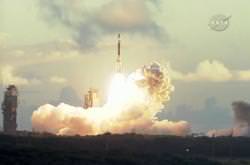The big day arrived, and nothing could keep that spacecraft on the ground. At 7:34 am EDT NASA’s Dawn spacecraft was lofted into space atop a Boeing Delta 2 rocket, beginning a 3 billion km (1.7 billion mile) journey to meet with two different large asteroids. If all goes well, the spacecraft will make its first encounter with Vesta in October, 2011, and then Ceres in February, 2015.
I know I say this about every mission, but this one, this mission is currently my favourite. In just a few years, a spacecraft is going to orbit an entirely unvisited asteroid, and then just a few years later, it’s going to do it again. It’ll all be so new, I can’t wait. They were once two asteroids, but now Ceres has been reclassified as a dwarf planet, along with Pluto in 2006.
Dawn will serve as a time machine, helping astronomers look back 4.6 billion years to the earliest times in our Solar System’s history. Although they’re both in the asteroid belt, between the orbits of Mars and Jupiter, Ceres and Vesta formed in dramatically different ways. Vesta was closer in, and is dry, without a trace of water – even its interior is probably still hot. Ceres formed further out, and astronomers think it might have a thick layer of ice under its crust, covering a rocky core.
Scientists are especially interested in the large crater on Vesta’s southern pole. It alone is 460 km wide and 13 km deep. Astronomers think this mighty collision could account for 5 percent of all the meteorites found here on Earth.
The key to Dawn’s ability to enter orbit around two different objects is its ion drive. Unlike a heavy chemical rocket, an ion propulsion drive uses solar power to accelerate xenon ions to tremendous speeds. It’s not a strong thrust, but it builds up over long periods helping the spacecraft reach tremendous speeds, with a relatively tiny mass of fuel.
NASA originally canceled Dawn, as part of its science cutbacks to help pay for the human missions to return to the Moon, but then the agency revived the mission in 2006, after they had already invested $449 million to get the mission to this point.
Dawn’s next task will be to report in to NASA, to confirm that it reached its proper trajectory, and is able to communicate. We’ll know later today if the mission hit its target window.
Next stop, Vesta.
Original Source: NASA/JPL News Release

